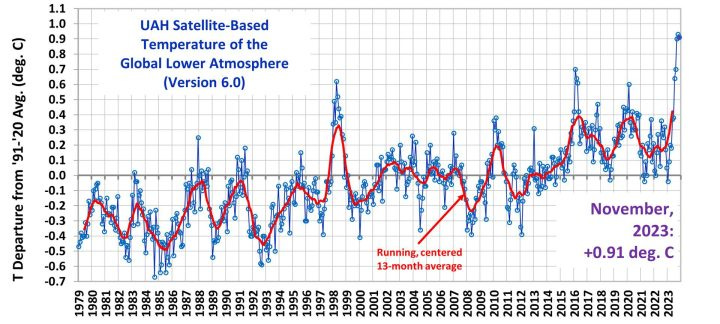UAH Global Temperature Nov 2023: +0.91C - The World Is Still Simmering After Coming To The Boil In Summer 2023
The world remains stubbornly very warm, despite the fact that it’s freezing here in the UK! Data. You can’t deny data.
That’s 3 months now of virtually unchanged global temperature after a rapid acceleration in warmth during the early summer and autumn. The world is ‘simmering’. Why? What’s causing it? Hausfather’s “weird” El Nino? It certainly is weird if it can supercharge global warmth during its development phase, cause global temperature to peak uncharacteristically early (in autumn) and somehow manage to maintain that peak warmth for three months (unlike other El Ninos which peak quickly and then start to cool - compare them on the graph above). So maybe it’s man-made global warming? No, there has been no sudden acceleration in GHG emissions and no passing of mysterious ‘tipping points’ in 2023. Climate change fanatics are going to have to take a back seat on this one.
So, it’s a complete mystery. The world is on a slow simmer and nobody knows why . . . . . .





It’s an interesting time, where multiple events coincide. The most important are the ones the so called “Climate Scientists” sweep under the carpet.
Undoubtedly the most important is the approx equivalent of 60000 Olympic size swimming pools of water that the Tonga volcano ejected into the stratosphere.
Secondary to this is the developing El Niño and the fact that the Atlantic Ocean multi-decadal oscillation is approaching it’s maximum. There is also the reduced cloud cover over the oceans, especially the North Atlantic, possibly since the introduction of low sulphur fuels which reduced cloud condensation nuclei, resulting in increased solar insolation.
One other important point is how the policy of Net Zero, where outlawing the burning of fossil fuels is reduce important cloud condensation nuclei, reducing cloud cover, increasing temperatures. Global warming then becomes a self fulfilling prophecy.
I too would tend towards natural variability, however it’s a complex area with very little data. Having spent several years cloud seeding on the edge of the ITCZ over river catchments, while seeing firsthand clouds rapidly develop and precipitate after seeding, while others simply evaporate and collapse just as quickly. Making it one of my favourite areas of interest, especially with regard to hygroscopic Nuclei.
Natures hygroscopic CCN’s, mainly provided by salt from sea spray. Volcanic ash. Smoke from forest and scrub fires with lightning being the ignition source. Dust and sand being lifted by the wind. Then there are cosmic rays etc, an topic outside my area.
The big questions.
As the earth matured, is there less volcanic ash.
As we try and prevent fires, are we reducing smoke.
To what extend has urbanisation, changes in farming and land use reduced the availability of dust. Has the burning of fossil fuels added to, or replaced possibly
falling natural smoke.
Whoever said the science is settled with regard to climate change, was pulling a fast one.